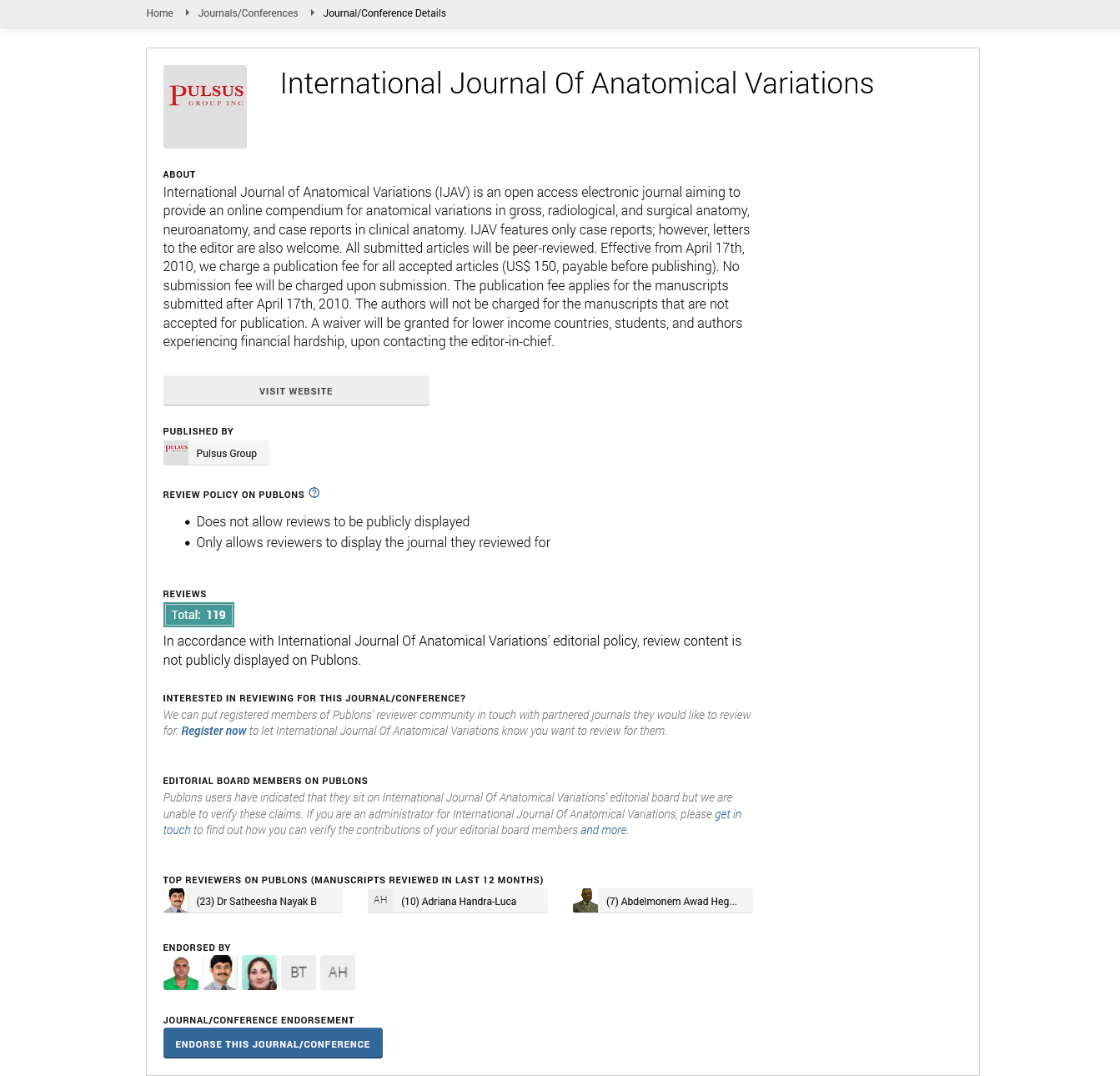Understanding Human Neuroanatomy Structure Function and Clinical Relevance
Received: 01-Apr-2025, Manuscript No. ijav-25-7668; Editor assigned: 04-Apr-2025, Pre QC No. ijav-25-7668 (PQ); Reviewed: 21-Apr-2025 QC No. ijav-25-7668; Revised: 26-Apr-2025, Manuscript No. ijav-25-7668 (R); Published: 30-Apr-2025, DOI: 10.37532/13084038.18(4).502
Citation: Kupper J. Understanding Human Neuroanatomy Structure Function and Clinical Relevance. Int J Anat Var. 2025; 18(4): 773-773.
This open-access article is distributed under the terms of the Creative Commons Attribution Non-Commercial License (CC BY-NC) (http://creativecommons.org/licenses/by-nc/4.0/), which permits reuse, distribution and reproduction of the article, provided that the original work is properly cited and the reuse is restricted to noncommercial purposes. For commercial reuse, contact reprints@pulsus.com
Abstract
Neuroanatomy, the study of the structure and organization of the nervous system, is foundational to neuroscience, neurology, and psychology. This article explores the intricate architecture of the human nervous system, including the central and peripheral systems, with particular focus on the brain and spinal cord. It discusses the functional correlations of anatomical structures, recent advances in imaging technologies, and the clinical implications of neuroanatomical knowledge. Understanding neuroanatomy is critical for diagnosing and treating neurological disorders and forms the basis for many biomedical innovations.
INTRODUCTION
Biological structure and function in the human nervous system [1]. As neuroscience continues to evolve, detailed anatomical understanding remains crucial for both clinical applications and research innovations. This article provides a comprehensive overview of neuroanatomical components, their functional roles, and their relevance to human health and disease. The human nervous system is one of the most intricate and vital systems in the body, governing everything from basic physiological functions to complex cognitive processes. At the heart of this system lies the field of neuroanatomy—the study of the structure and organization of the nervous system. Understanding neuroanatomy is not only fundamental for students and professionals in neuroscience and medicine, but it is also essential for diagnosing, treating [2], and managing a wide range of neurological conditions. Neuroanatomy provides the framework for interpreting how different parts of the brain and nervous system interact to produce behavior, regulate bodily functions, and respond to injury or disease. It encompasses the macroscopic organization of the brain and spinal cord as well as microscopic components such as neurons and glial cells. Moreover [3], advances in imaging technologies and molecular neuroscience have made it possible to explore the structure and function of the nervous system with unprecedented detail. Explores the essential aspects of human neuroanatomy focusing on its structural complexity the functional roles of its components and its clinical significance. Through this understanding, we can appreciate the delicate architecture that underlies our thoughts, actions, and experiences and the implications when that architecture is disrupted [4].
CENTRAL NERVOUS SYSTEM
The CNS consists of the brain and spinal cord. It is protected by the skull and vertebral column and surrounded by meninges and cerebrospinal fluid. The brain is divided into the cerebrum, cerebellum, and brainstem. The largest part, responsible for cognitive functions, sensory processing, and voluntary movement. Coordinates motor activity and balance. Controls autonomic functions such as heart rate, respiration, and sleep cycles. Transmits information between the brain and the rest of the body; involved in reflex arcs [5].
PERIPHERAL NERVOUS SYSTEM
The PNS includes all neural elements outside the CNS, comprising cranial and spinal nerves. Controls voluntary muscle movements. Regulates involuntary functions. Prepares the body for stress. Conserves energy and promotes maintenance activities.
NEUROSURGICAL APPLICATIONS
Precise anatomical knowledge ensures safe and effective surgical interventions, such as in epilepsy surgery or tumor resection.
RECENT ADVANCES AND FUTURE DIRECTIONS
Neuroanatomy is evolving with computational modeling, connectomics, and high-resolution mapping. These approaches aim to construct a detailed atlas of brain connections and their functional implications.
CONCLUSION
A comprehensive understanding of neuroanatomy is crucial for advancing medical practice and neuroscience research. With ongoing technological and methodological improvements, our grasp of the human nervous system continues to deepen, paving the way for improved diagnostics, therapies, and neural engineering applications.
REFERENCES
- Szymczak M, Krupa P, Oszkinis G, Majchrzycki M. Gait pattern in patients with peripheral artery disease. BMC Geriatrics. 2018; 18:52.
- Nayak SB, Shetty P, Surendran S, Shetty SD. Duplication of Inferior Gluteal Artery and Course of Superior Gluteal Artery Through the Lumbosacral Trunk. OJHAS. 2017; 16.
- Patel SD, Perera A, Law N, Mandumula S. A novel approach to the management of a ruptured Type II endoleak following endovascular repair of an internal iliac artery aneurysm. Br J Radiol. 2011; 84(1008):e240-2.
- Rayt HS, Bown MJ, Lambert KV. Buttock claudication and erectile dysfunction after internal iliac artery embolization in patients prior to endovascular aortic aneurysm repair. Cardiovasc Intervent Radiol. 2008; 31(4):728-34.
- Fontana F, Coppola A, Ferrario L. Internal Iliac Artery Embolization within EVAR Procedure: Safety, Feasibility, and Outcome. J Clin Med. 2022; 11(24):73-99.
Indexed at, Google Scholar, Crossref
Indexed at, Google Scholar, Crossref
Indexed at, Google Scholar, Crossref






